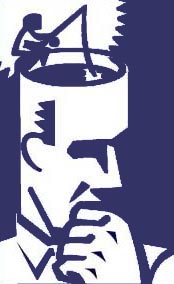 |
DOT SMOKE An Inherently Good Vision // by Grenzfurthner "Father,
why is the sky black?" |
||
On July 14, 1881 the "Book of 96 Fools" was published in Berlin – the first telephone book. It was popularly called the "Book of 96 Fools", because the (so-called) man from the street pitied them, these first 96 German participants that had fallen for this "swindle from America": the telephone. Innovation? The relationship between what is new and innovation is by no means apriori clear: not everything that is merely new is called innovation (see: the new winter collection or the new construction of a normal residential building), and not every innovation consists entirely of something new. A certain novelty, specific new aspects – regardless of how they are specified – are necessary conditions for an innovation. Thus before we turn to more complex questions of scientific or economic innovations, we should address the seemingly simple question of what "new" actually means and what are the criteria for what is new. How does something new become New? The new always presupposes a beginning without a predictable end, because otherwise the new could be simply derived from the old and would thus be formally situated in a clear and unequivocal connection with the given. In this respect, old Sir Popper rightly speaks of the non-prognosticability of new knowledge. What is new breaks with the past and establishes a beginning. This is also the reason for its close proximity to chance. Mountains of books have been written on innovation in the attempt to weed out exactly this moment of chance from the innovation process – in the end it pops up like a little pixie in a hidden place. I stood there and stared into the sky. It is easy to make a smaller smoke ring machine. But I wanted to make smoke rings with a diameter of seventeen meters. I thought about it. I would have to build a combustion chamber as high as a house and as big as a soccer field. But maybe there is a different, more economical way. It is possible to build semi-rigid structures from air-filled fabric tubes. Firm walls of this type would resemble an air mattress. My "smoke ring chamber" could thus be built with a sewing machine and a few old parachutes (which can be obtained). A small fan would do to provide the pressure. I could make a 35-meter wide "igloo"-shaped construction with a 17-meter large hole in the center of the roof. Then the smoke rings could get out through the top. To produce a smoke ring, I would thus put the chamber under pressure: a "venetian blind" is placed over the hole, which is closed in the beginning. Another fan then raises the pressure a little. A foldable supplementary chamber might even be added to the main chamber, which would have rubber ropes around it so that it could be inflated like a balloon. When the venetian blind is opened suddenly, the air escapes quickly, forming a ring spiralling upward as it does so. To make the spiral visible, I would heat the air and generate a mist using a condensation vaporizer. When the heated air meets with the outside air, the drop in temperature creates additional fog. I expect that the 17-meter smoke ring will have a very long life. As it floats upward, the warm air will carry it much higher than a generator normally would. The ring-shaped cloud might even reach the stratosphere and produce a real cloud. That would probably look very strange on a cloudless day. If I start the generator repeatedly, a chain of 17-meter-wide smoke rings would rise up slowly into the sky. There would be a perpendicular, dotted, kilometer-high line from the ground up to the sky. Smoke "pixels" against the background of the blue sky, very similar to the laser spotlights used at night for vulgar advertising and village discos. It could probably be seen for a hell of a long way in the distance in the daylight. So let us stand with both feet firmly in the clouds. With a series of ten huge generators built side by side, we could make gigantic dot-matrix [1] letters rise up to the sky ... [1] Note for non-nerds: dot-matrix printers are also known as pin-printers. Not many are sold anymore, though. Comment by Jim Janecek
|
|||
